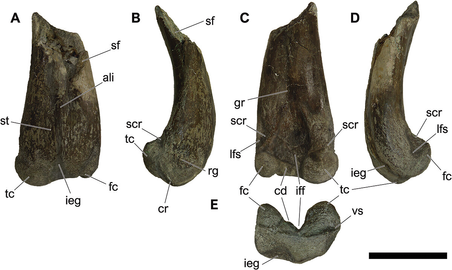MEANING: Tieta lizard
PERIOD: Early Cretaceous
CONTINENT: South America
Tietasaura is an elasmarian dinosaur from the Early Cretaceous period of what is now Brazil. Elasmaria is a group of relatively small basal ornithopods known from the Southern Hemisphere. Tietasaura is notable for being the first ornithischian dinosaur named from Brazil. It was a bipedal herbivore, with a long neck and a beak which it used for processing vegetation. Teatasaura was medium-sized for an elasmarian, reaching about 4 m in length.

Abstract from paper: Supposed dinosaur remains were collected between 1859 and 1906 in the Lower Cretaceous Recôncavo Basin (Northeast Brazil). Since these materials remained undescribed, and most were considered lost. Recently, some of these historical specimens were rediscovered in the Natural History Museum of London, providing an opportunity to revisit them after 160 years. The specimens come from five different sites, corresponding to the Massacará (Berriasian-Barremian) and Ilhas (Valanginian-Barremian) groups. Identified bones comprise mainly isolated vertebral centra from ornithopods, sauropods, and theropods. Appendicular remains include a theropod pedal phalanx, humerus, and distal half of a left femur with elasmarian affinities. Despite their fragmentary nature, these specimens represent the earliest dinosaur bones discovered in South America, enhancing our understanding of the Cretaceous dinosaur faunas in Northeast Brazil. The dinosaur assemblage in the Recôncavo Basin resembles coeval units in Northeast Brazil, such as the Rio do Peixe Basin, where ornithopods coexist with sauropods and theropods. This study confirms the presence of ornithischian dinosaurs in Brazil based on osteological evidence, expanding their biogeographic and temporal range before the continental rifting between South America and Africa. Additionally, these findings reinforce the fossiliferous potential of Cretaceous deposits in Bahia State, which have been underexplored since their initial discoveries.
Tietasaura is from the Cretaceous. The Cretaceous is a geological period that lasted from about 145 to 66 million years ago. It is the third and final period of the Mesozoic Era, as well as the longest. At around 79 million years, it is the longest geological period of the entire Phanerozoic. The name is derived from the Latin creta, "chalk", which is abundant in the latter half of the period.
The Cretaceous was a period with a relatively warm climate, resulting in high eustatic sea levels that created numerous shallow inland seas. These oceans and seas were populated with now-extinct flora and fauna, while dinosaurs continued to dominate on land. The world was ice free, and forests extended to the poles. During this time, new groups of mammals and birds appeared. During the Early Cretaceous, flowering plants appeared and began to rapidly diversify, becoming the dominant group of plants across the Earth by the end of the Cretaceous, coincident with the decline and extinction of previously widespread gymnosperm groups.
The Cretaceous (along with the Mesozoic) ended with the Cretaceous–Paleogene extinction event, a large mass extinction in which many groups, including non-avian dinosaurs, pterosaurs, and large marine reptiles, died out. The end of the Cretaceous is defined by the abrupt Cretaceous–Paleogene boundary (K–Pg boundary), a geologic signature associated with the mass extinction that lies between the Mesozoic and Cenozoic Eras.
Tietasaura is an ornithopod. Ornithopoda is a clade of ornithischian dinosaurs that started out as small, bipedal running grazers and grew in size and numbers until they became one of the most successful groups of herbivores in the Cretaceous. They dominated the North American continent, then spread to Asia and eventually the southern hemisphere toward the end of the Cretaceous. Their major evolutionary advantage was their batteries of teeth, which allowed them to process vegetation in an extremely efficient way. Ornithopods were a diverse group, and included the hadrosaurs, which continued to dominate until the Cretaceous–Paleogene extinction event, which wiped out all non-avian dinosaurs.









